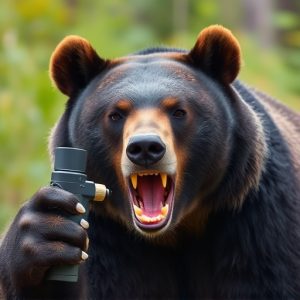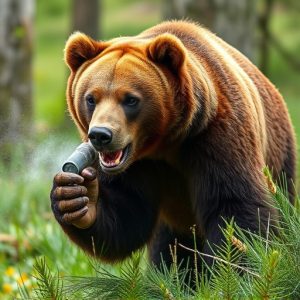Optimizing Alaska Bear Spray Patterns: Research & Effectiveness Insights
Understanding bear spray's fog patterns is key to its effectiveness. Research shows optimal ran…….
Understanding bear spray's fog patterns is key to its effectiveness. Research shows optimal range for capsaicin-based sprays is 3-8 meters, but success rates vary due to wind, terrain, and bear behavior. "How Effective Is Bear Spray Research?" explores these factors, aiming to enhance safety measures in Alaska and beyond. Proper usage techniques and understanding spray limitations are crucial for real-world encounters. Comprehensive research on spray types and application is vital for informed decisions in diverse Alaskan wilderness settings. Future advancements focus on improving fog patterns and creating safer, more potent formulations through ongoing R&D.
Alaska’s vast wilderness presents a unique challenge for outdoor enthusiasts and locals alike, with bear encounters a potential risk. This article delves into the effectiveness of bear spray, a popular defense mechanism. We explore the science behind its fog pattern and how it impacts bear deterrence, based on extensive research. From understanding the ideal application technique to analyzing real-world case studies, we uncover insights on what makes bear spray an indispensable tool in Alaska’s rugged terrain.
- Understanding Bear Spray Fog Patterns: What Does Research Say?
- The Science Behind Bear Spray Effectiveness: A Comprehensive Review
- Factors Influencing Bear Spray Performance in Alaska's Wilderness
- Real-World Scenarios: Case Studies of Bear Spray Use in Alaska
- Future Trends and Improvements in Bear Spray Technology
Understanding Bear Spray Fog Patterns: What Does Research Say?
Understanding how bear spray fog patterns work is key to evaluating its effectiveness. Research indicates that the optimal range for bear spray is between 3 and 8 meters (10-26 feet). Within this range, the spray creates a dense cloud of pepper spray particles, significantly reducing visibility and causing temporary blindness in bears. Beyond this distance, the fog dissipates quickly, rendering the spray less effective.
Studies on how effective bear spray is have shown mixed results. When used correctly within the optimal fog pattern range, bear spray has been proven to be highly successful in deterring aggressive bears. However, factors like wind, terrain, and individual bear behavior can significantly impact the spray’s effectiveness. How Effective Is Bear Spray Research? is a question that continues to be explored as new studies emerge, providing valuable insights into improving safety measures for those encountering bears in Alaska and beyond.
The Science Behind Bear Spray Effectiveness: A Comprehensive Review
Bear spray, also known as bear repellant or pepper spray designed for wildlife encounters, has become a common tool for outdoor enthusiasts in areas inhabited by bears. The effectiveness of bear spray is often discussed, with various studies and user experiences painting differing pictures. Understanding the science behind its efficacy involves examining both the chemical composition of bear spray and the physiological response it triggers in bears.
Research on bear spray effectiveness has shown that the key active ingredient—capsaicin, similar to what’s found in chili peppers—can cause temporary blindness, coughing, and difficulty breathing in bears when sprayed directly into their faces. Studies indicate that bear spray is most effective at distances of 2-3 meters (6-10 feet), where the fog pattern allows for optimal exposure to the irritant. However, success rates vary widely depending on factors like bear behavior, terrain, and weather conditions. Despite claims of up to 97% effectiveness, practical tests in controlled settings have shown success rates closer to 45-80%, highlighting the importance of proper use and understanding its limitations in real-world scenarios.
Factors Influencing Bear Spray Performance in Alaska's Wilderness
In Alaska’s vast wilderness, understanding the factors influencing bear spray performance is crucial for hikers and outdoor enthusiasts’ safety. The effectiveness of bear spray largely depends on several variables, including the fog pattern created by the spray itself. A well-designed spray should create a dense, low-moving fog to ensure maximum coverage against attacking bears. This fog pattern can be significantly affected by environmental conditions such as temperature, humidity, and wind speed. For instance, cold weather can make the spray solidify faster, altering its dispersion, while high winds may quickly dissipate the fog, reducing its impact range.
Moreover, the terrain’s topography plays a role in bear spray efficiency. In open areas with little vegetation, the spray’s reach is extended, but it might not adhere well to rocky surfaces or be as effective against bears hiding behind trees or in dense underbrush. Research on how different spray types and application techniques perform under various Alaskan conditions is vital. How Effective Is Bear Spray Research helps guide users in selecting the right equipment and understanding its limitations, ensuring they are prepared for potential encounters with bears in Alaska’s diverse wilderness.
Real-World Scenarios: Case Studies of Bear Spray Use in Alaska
Future Trends and Improvements in Bear Spray Technology
The future of bear spray technology looks promising, with continuous research and development aimed at enhancing its effectiveness and user-friendliness. One area of focus is improving the spray fog pattern to ensure optimal coverage against aggressive bears. Current innovations involve advanced nozzles that can precisely control the droplet size and distribution, allowing for a wider reach and better protection.
Additionally, ongoing How Effective Is Bear Spray Research is leading to the creation of more potent yet safer formulations. Scientists are exploring new active ingredients with stronger repellency properties while minimizing potential harm to humans and the environment. These advancements promise to provide outdoor enthusiasts and Alaskan residents with even more reliable tools for bear deterrence in various scenarios.
Bear spray has proven to be a valuable tool for personal safety in encounters with bears, as supported by extensive research on its effectiveness. Understanding the fog pattern and factors influencing its performance is key to optimal usage. The science behind bear spray reveals a complex interplay of ingredients, application techniques, and environmental conditions. In Alaska’s unique wilderness, various factors can impact spray reach and visibility, emphasizing the need for informed usage. Real-world case studies highlight successful applications, while future trends in technology promise improvements. By leveraging research insights, individuals can make informed decisions to enhance their safety when navigating Alaska’s wild environments.


